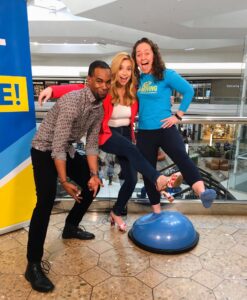We have so many exercise options for improving balance. The key is to come up with exercises you will commit to because it takes time to see improvement in balance. You need to devote 30-50 min workouts 2-3 times per week for 12 weeks, 8 weeks for athletes. But do that and research shows you will develop better balance. Balance training is worthwhile. When you workout for balance you additionally gain strength and reduce the chance of injury.
Below are some exercise suggestions, but, ultimately, you want to make balance training a game and make it playful. Balance with a friend. Balance outside. Figure out what will make you commit to balance training for 12 weeks.
Tips for Better Balance:
To help you remember these balance tips, consider the acronym BASIC—there is a little cheat in this one (you’ll SEE what I mean).
-
Spend time BAREFOOT
This option isn’t for everyone right away. If you have a foot injury or being barefoot hurts your feet, you will need to build up over time. But if you are okay being barefoot, walk around in safe spaces. Or try some exercises without shoes. If this is new to you, you don’t need to do every move barefoot. Take your time progressing.
To start walk around a carpeted room barefoot. Balance on one foot barefoot. And try tandem walking barefoot. Lunges and squats are a great exercise to progress to if it feels safe for you.
-
Walk & Exercise on ASSORTED SURFACES
Multiple studies showed that balance training was effective when participants explored different surfaces. They walked on mattresses, foam pads, or low balance beams. You can find different surfaces to move on—walk on a sidewalk, go for a walk in the woods, or walk through the grass.
You can also pick unstable surfaces to exercise on. Like doing squats on a BOSU ball, arm exercises on a balance disc, or simply standing on a balance board.
-
Try STATIC & Dynamic Moves
To improve balance, you’ll want to play with two types of movements. Static exercise doesn’t involve movement. Balancing on one leg is an example of a static exercise. Balancing on your toes is another. Holding tree pose in yoga is another.
Dynamic movements mean the body is moving while you are working on balance. A tandem gait (walking one foot in front of the other where the toes of the back foot touch the front foot—think of the image of someone getting pulled over for DUI) would involve movement while you balance. The tipping bird where you balance on one leg while you hinge forward at the hips and lift your free leg in the air is another. You can get creative. Any movement you do while standing on one foot is going to make the move dynamic. You can twist and wiggle.
-
Progress to EYES closed.
Here’s where I cheated a bit. The “I” in BASIC is really our eyes. Over time you want to progress to trying some of these exercises with your eyes closed. To move to this too soon. Make sure you feel ready. When you do start with some of the simpler moves and static exercises. Make sure you are somewhere safe. If you never feel right about closing your eyes. Don’t. It’s not the end of the world.
Some balance training research included eye exercises. It was unclear the specifics of what that entailed, but I imagine balancing while doing something that involves a little hand-eye coordination. Your eyes and ears play a huge role in balance. It’s one of the reasons we lose balance as we age—our vision and hearing also decline, so exploring how balance feels when we take our vision away is helpful to the nervous system learning where we are in space without our vision.
-
Train your CORE
Never neglect your core. It’s the center of our very being. Core exercises like front plank, side place, bridges, and exercises on a swiss ball have been shown to improve balance. So get planking. If you need to distract yourself we have plenty of funny stories (I call them plank stories) on this blog you can read while you hold a 90-second plank.
Additional Reminders for Better Balance
Start with a wall to help you balance at first. It’s not a cheat. It’s a modification. If you can’t even do a movement you’ll never get there without a little support. Use the wall or a sturdy chair. Progress off of it as you feel improvement.
This video clip from NBC CT Live touches on all these concepts:
Keep Reading
Do you need to work both sides of the body evenly? Click here to find out what Maggie thinks.
Here are some additional exercises that should help improve balance.
This is a sample plank story for when you try holding plank.
Keep Connected
Order Your Copy of Keep Moving Today!
Subscribe to the Keep Moving Blog
Like the Personal Euphoria Facebook page
Find us on Twitter
Follow me on Instagram
Subscribe to my YouTube Channel

